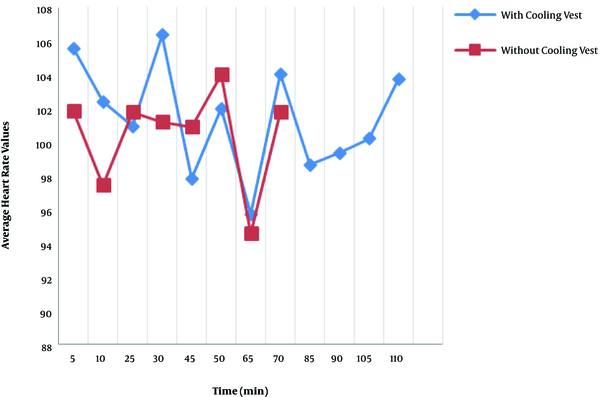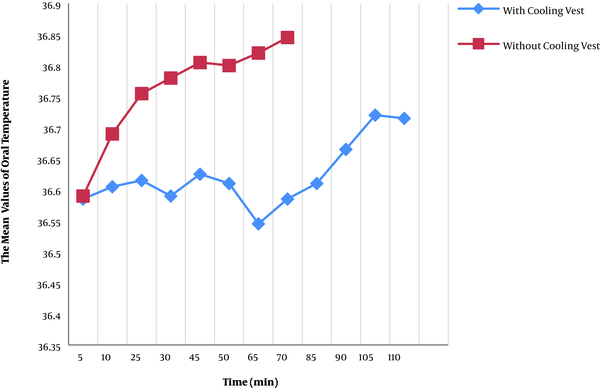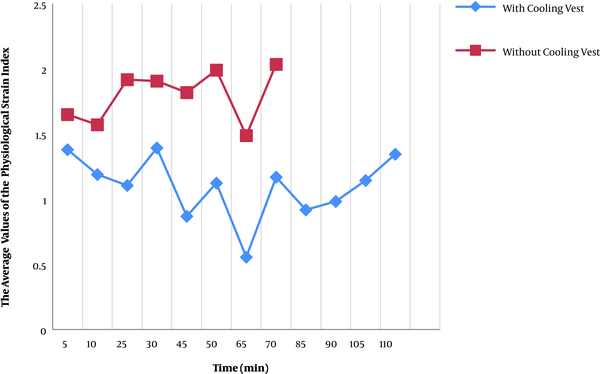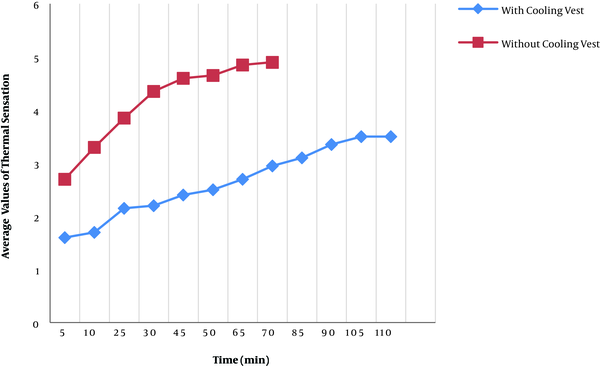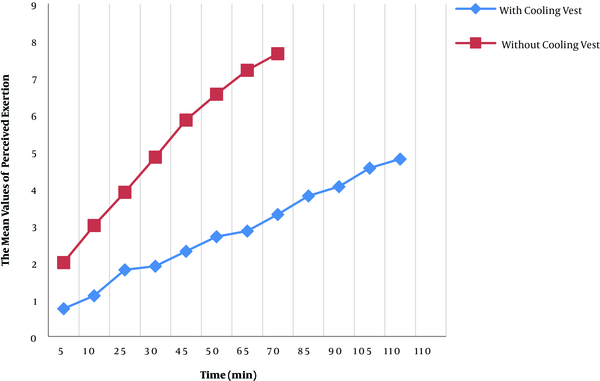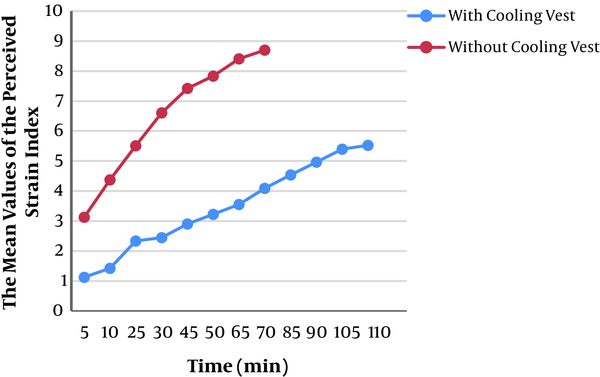1. Background
People who work in hot environments are exposed to thermal stress. This exposure causes physiological changes called “the thermal strain in the body”. If the thermal strain is not controlled, it can lead to diseases and disorders due to heat, i.e., heat disturbances, such as muscle cramps, heat loss, as well as reducing useful work, productivity, and physical and cognitive performance of the workers (1).
Moreover, an increase in the body temperature and dehydration can lead to negative behavioral traits and other complications, such as physical fatigue, irritability, lethargy, impaired judgment, as well as the loss of skill, concentration, and coordination of the workers, which potentially endangers the occupational safety (2).
There are various ways to control the effects of heat strain, among which personal cooling clothes are a useful and cost-effective solution in reducing the effects of heat exposure and increasing the working time in hot environments (3). In this regard, phase change materials (PCM) cooling vests, air, and liquid cooling vests, and ventilated cooling vests have been used in recent decades (4).
Air and liquid cooling vests and compressed air conditioning vests are mainly used for physical activities at a low level. However, PCM cooling vests, due to their greater mobility, lighter weight, and more cooling power in some types, are more widely used compared with the other two types of vests for outdoor activities (5). PCMs absorb or release heat by converting from solid to a liquid by changing the ambient temperature or vice versa, by which they provide their cooling and heating effects (6). Among the PCMs, the most famous substance is water, which is frozen at 0°C and has a latent heat capacity of 335 J/g (5). Moreover, using ice vests can reduce the heart rate, skin temperature, and sweating (7, 8). However, the effect of ice cooling vests on the thermal strain depends on different factors, such as gender.
Various studies have been conducted on the effectiveness of PCM cooling vests on men (7, 9, 10). Zare et al. (11) assessed the characteristics of ice cooling vests were optimized for the increased comfort and applicability in men. However, these studies have been conducted on men.
In the same thermal load conditions, women have higher core temperature, skin temperature, heart rate, and lower sweating rates than men (12). Also, women have significantly higher levels of fat-storage than men, which acts as insulation against heat disposal (13). These factors make women more vulnerable to heat strain than men. Women also have different physical characteristics than men (14), which makes the cooling effect of the ice vest designed for men different in women, and it may not be able to properly control their thermal strain.
According to the report by the Statistical Center of Iran in 2015, the number of employed women is 228,789,839 people in the agricultural sector, 238,823,704 in the industrial sector, and 5,341,846,966 in the service sector (15).
2. Objectives
Because of women's increased participation in different professions, the Islamic clothing, and since there has been no study to design PCM cooling vests for women, the aim of this study was to evaluate the effect of an optimized cooling vest for controlling the strain of women in warm laboratory conditions.
3. Methods
The present study was done in two steps, including designing, producing, and optimizing the cooling vest for women, as well as evaluation of the effectiveness of the designed cooling vest to control the thermal strain.
3.1. Step 1: Design and Preparing of the Cooling Vest for Women
At this stage, considering the anthropometric structure of the women’s body, first, a suitable location was chosen to place the packs. A 5-point scale (1, comfortable; 2, a little hot; 3, warm; 4, hot; and 5, very hot), as well as a checklist, including 9 questions assessing the level of tightness, comfort, flexibility, being easy to wear and take out, limiting the body movements, and adjusting the vest to fit the body were used to determine the appropriate place for the pack of thermal sensation (TS) index. The questions were scored on a five-point Likert scale, from “strongly disagree”, “disagree”, “undecided”, “agree”, to “strongly agree”. The inclusion criteria were no history of cardiovascular and musculoskeletal disorders, seizure, epilepsy, pulmonary and neurological diseases, diabetes, no use of hypertension medications affecting the heart rate, as well as no use of coffee, caffeine, and alcohol 12 h before the test. Before the test, the subjects were examined by the physician to meet the inclusion criteria. The exclusion criteria included an increase in a person’s heart rate to 180 beats/min and temperature to 39°C, as well as excessive fatigue (10). The informed consent was obtained before the test from all participants. They were also informed about filling in the questionnaires and the exclusion criteria. Then, the test was carried out on ten female students of Isfahan University of Medical Sciences under the hot laboratory condition on a treadmill in a climatic chamber with a mean temperature of 36°C, relative humidity of 36%, at a speed of 2 km/h, and a zero-degree gradient with the cooling vest (6 steps in 10 min). The TS index was recorded every 10 min during the test.
The location of the packs was changed in three steps: (A) nine pockets were designed inside the vest for fitting the cooling packs. The number of pockets in front and back of the vest was 4 and 5, respectively; (B) to prevent the pressure, the packs in the front of the vest were placed below the breasts. The shoulder region was designed considering the adjustability for the upper body, and the waist area was designed with a changeable size for tightening and widening the cooling vest. The pack position was changed from the horizontal to vertical below the front section, and the pack size could change from 9 × 16 cm to 8 × 14 cm; (C) the pack position was changed from horizontal to vertical in the upper part of the back section to provide greater flexibility and a better thermal feeling. The designing steps of the cooling vest are shown in Appendix 1 in Supplementary File.
The location of the packs was changed according to the students’ opinion regarding the convenience at the time of wearing the vest and also considering the time points, at which the most cooling sensitivity was felt. The extra weight of the vest could increase cooling duration (16); however, it reduced the person’s mobility. Therefore, seven packs of 150 g with 9 × 16 cm in dimension and two packs of 120 g with 8 × 14 cm in dimension were used for the designed vest. The ice gel packs consisted of water and a water-absorbent polymer packaged in a 300-micron thick plastic coating.
The researchers aimed at designing a vest with a lower weight and greater flexibility and being more convenient compared with those made for men. The total weight of the vest was 1500 g, and the fabric used for the cooling vest included 30% cotton and 70% polyester.
Also, regarding the fact that the phase change temperature of the ice gel pack is about 0°C, its long-term contact with the body can lead to tissue damage. To reduce the direct effects of ice gel on the skin, 2-mm thick foamed coatings were used for embedding the ice gel packs. This foam coating fixed the surface temperature of the ice gel packs at around +10 and -1°C. Moreover, the foam makes it possible to increase the cooling duration of the cooling vest. Figure 1 shows the designed cooling vest.
3.2. Step 2: Evaluation of the Effectiveness of the Cooling Vest Designed to Control the Thermal Strain
3.2.1. Participants
This research was conducted on 20 female students of Isfahan University of Medical Sciences. The inclusion and exclusion criteria, as well as ethical considerations, were similar to step 1.
To unify the conditions of using the cooling vests, the volunteers used similar types of working clothes, including t-shirts and pants made of 70% polyester and 30% cotton. To charge the cooling packs, they were kept in a freezer overnight before the test.
3.2.2. Study Design
Participants were asked to relax for 15 min before entering the chamber, and their heart rate and oral and skin temperatures were measured. The climatic chamber was prepared at an average temperature of 37°C and relative humidity of 39% before the entrance of the participants. Participants performed the tests in two modes, i.e. with and without the designed cooling vests. During the tests, the effect of cooling vests on the oral temperature, heart rate, TS, and perceived exertion (PE) was evaluated.
The cooling vest test included six 10-min steps and the test without the cooling vest included four 10-min steps on a treadmill at a speed of 2 km/h and a zero-degree gradient. Due to the high-temperature strain, the steps of the testing without a cooling vest had two steps less than the test using the cooling vest. The heart rate, oral temperature, TS, and PE were measured every 5 min during the tests. After 10 min of physical activity, the person stopped exercising on the treadmill, and the heart rate was measured and recorded three times in succession in 3 min to evaluate p1, p2, and p3.
Moreover, at the end of each stage, the participants were asked to express their TS and PE based on the specific scales. The wet bulb globe temperature (WBGT) index, air temperature, wet temperature, and relative humidity were recorded after each stage to control the ambient conditions of the chamber.
3.2.3. Data Collection Tools
The WBGT device (Casella; accuracy: 0.1; the UK) was used to measure the ambient conditions of the chamber, including air temperature, wet temperature, relative humidity, and WBGT. Also, the Jax207 fingerprint pulse rate-meter (China) was used to measure the heart rate. The oral temperature was also measured using Brauer oral thermometer (accuracy: 0.1; Germany).
Equation 1 was used to calculate the physiological strain index (PSI):
Where Tct is the core (oral) temperature of the body during activity, Tct0 is the core (oral) body temperature at rest, HRc is the heart rate during activity, and HRc0 shows heart rate at rest. The final PSI score is a 10-point scale, in which zero and 10 indicate the absence of the strain and the highest amount of strain, respectively (17). The perceived strain index (PeSI) was used to assess the perceived strain.
Equation 2 was used to evaluate PeSI:
Where, TS is a 5-point scale (1, comfortable; 2, a little hot; 3, warm; 4, hot; and 5, very hot), and PE is a 10-point scale (0, extremely easy and 10, very difficult). The final score of the PeSI indicates a 10-point scale, in which zero and 10 show the absence of the strain and the highest amount of strain, respectively (18).
3.2.4. Data Analysis
Finally, the data were analyzed by SPSS (Ver. 22) and Excel 2013. The Kolmogorov-Smirnov test was used to check the normal distribution of data and the paired t-test was used to compare the data at different time points. P < 0.05 was considered significant with 95% confidence intervals.
4. Results
4.1. Step 1
The mean age and weight of the participants were 23.7 ± 1.25 and 56.40 ± 6.099, respectively. Table 1 presents the mean comfort of the cooling vest and TS at each step.
| Step | Assess the Comfort of the Vest | Threshold Sensation |
|---|---|---|
| A | 2.9293 ± 0.22373 | 2.5000 ± 0.24513 |
| B | 3.4242 ± 0.19763 | 2.1000 ± 0.19107 |
| C | 4.0404 ± 0.12445 | 1.8429 ± 0.12509 |
Mean and Standard Deviation of the Comfort of the Cooling Vest and Threshold Sensation at Each Design Stepa
4.2. Step 2
The mean age and weight of participants were 24.5 ± 5.09 and 56.99 ± 6.99, respectively. The mean environmental parameters in the two test modes with and without the designed cooling vest are given in Table 2. The Kolmogorov-Smirnov test showed that the data distribution was normal (P > 0.05). The results of statistical analysis using paired t-test showed no significant difference between mean air temperature, wet temperature, relative humidity, and WBGT of the climatic chamber in the two test modes (P > 0.05).
| Parameter | Test Mode | Minimum | Maximum | Mean ± SD | P Value |
|---|---|---|---|---|---|
| WBGT | Without the cooling vest | 29.15 | 33.08 | 30.1687 ± 0.9243 | 0.131 |
| With the cooling vest | 29.38 | 30.85 | 29.8667 ± 0.3975 | ||
| Air temperature | Without the cooling vest | 36.45 | 39.53 | 37.7638 ± 0.6151 | 0.350 |
| With the cooling vest | 35.92 | 39.57 | 37.6082 ± 0.8966 | ||
| Wet temperature | Without the cooling vest | 25.35 | 28.15 | 26.4375 ± 0.8030 | 0.464 |
| With the cooling vest | 25.5 | 27.27 | 26.3083 ± 0.4621 | ||
| Relative humidity | Without the cooling vest | 33.95 | 47.7 | 39.182 ± 3.3486 | 0.959 |
| With the cooling vest | 33.07 | 47.15 | 39.1275 ± 3.9899 |
Mean and Standard Deviation of the Environmental Indicators Measured in the Chamber of Thermal Stresses
The mean heart rate, oral temperature, and PSI at different time points in both test modes are shown in Figures 2-4, respectively. The mean heart rate and oral temperature during the test with the cooling vest were lower compared with without cooling vest. In the meantime, the paired t-test showed no significant difference between the mean heart rate and oral temperature in the two test modes (P > 0.05). However, the difference in the PSI between the two test modes was significant. Also, the statistical analysis showed no significant difference between resting heart rate in the P1, P2, and P3 states in the two test modes (P > 0.05).
The paired t-test results for comparing the average physiological parameters measured in the two modes are presented in Table 3. The mean TS, PE, and PeSI at different time points in the two the test modes are shown in Figures 5-7, respectively. The results of the statistical analysis showed that the mean rates of TS, PE, and PeSI with the cooling vest were significantly lower compared with without a vest (P < 0.05).
| Parameter | Test Mode | Values | P Value |
|---|---|---|---|
| Oral temperature | Without the cooling vest | 36.6594 ± 0.57368 | 0.289 |
| With the cooling vest | 36.5742 ± 0.55759 | ||
| Heartbeat | Without the cooling vest | 99.0889 ± 15.69605 | 0.241 |
| With the cooling vest | 100.9 ± 11.8512 | ||
| Resting heart rate (P1) | Without the cooling vest | 94.05 ± 14.66795 | 0.290 |
| With the cooling vest | 95.9417 ± 11.73592 | ||
| Resting heart rate (P2) | Without the cooling vest | 91.3125 ± 14.84501 | 0.152 |
| With the cooling vest | 94.1583 ± 10.62498 | ||
| Resting heart rate (P3) | Without the cooling vest | 92.7417 ± 13.42946 | 0.727 |
| With the cooling vest | 92.1625 ± 12.08226 | ||
| PSI | Without the cooling vest | 1.5986 ± 0.70226 | 0.029 |
| With the cooling vest | 1.0147 ± 0.92352 |
Paired t-test Results for Comparing the Mean Physiological Parameters Measured During a Test with and Without a Cooling Vesta
Also, the results of the t-test for the comparison of the mean perceptual parameters in the two modes are provided in Table 4.
| Parameter | Test Mode | Values | P Value |
|---|---|---|---|
| Threshold sensation | Without the cooling vest | 3.8 ± 0.47497 | 0.000 |
| With the cooling vest | 2.5115 ± 0.78059 | ||
| Perceived exertion | Without the cooling vest | 4.5556 ± 1.46433 | 0.000 |
| With the cooling vest | 2.6077 ± 1.09411 | ||
| Perceived strain index | Without the cooling vest | 5.7939 ± 1.15003 | 0.000 |
| With the cooling vest | 3.2055 ± 1.25747 |
Paired t-test Results to Compare the Mean of Perceptual Parameters Measured During the Test with and Without a Cooling Vesta
5. Discussion
The environmental parameters measured in the climatic chamber, including WBGT, air temperature, wet temperature, and relative humidity were not significantly different for the two experimental conditions, indicating that the two test steps were performed under the same conditions, and the measured indicators were influenced by the cooling effect of the cooling vest.
In this study, PSI and PeSI were significantly lower while using the cooling vest. While wearing the cool vest, blood flow from the surface of the skin is cooled, and the heat transfers between the blood and skin can reduce body temperature (19). Since the core body temperature changes, it can affect the heart rate, as a decrease in body temperature can reduce the heart rate (20).
In a study by Yazdanirad and Dehghan conducted on 10 male students on the treadmill in the climatic chamber with a temperature of 40°C and relative humidity of 40% with two low- and medium-intensity physical activities, the results showed a significant difference between the mean heart rate, oral temperature, and skin temperature while using a vest with commercial paraffin with a melting temperature of 30°C compared with without vest. Also, Gao et al. (21) in 2012 examined whether a personal cooling with phase change materials could improve the thermal comfort in a simulated office at 34°C. They concluded that the skin temperature of the trunk decreased by about 2°C - 3°C and remained at 33.3°C. Also, the TS had improved in the whole body and torso (21). The difference between the results of the present study and the mentioned research can be due to gender, lack of compatibility with the heat, and physical capacity of the participants.
Other studies also have reported the effects of lack of cooling vests on some physiological factors in females. In a study by Zhao et al. (22) conducted on eight female students to compare the effect of two types of PCM and ventilating cooling vest on thermal comfort in an environment with a temperature of 32°C and relative humidity of 50% on a treadmill, the test was conducted using three groups: a group with PCM cooling vests with a melting point of 24°C, a group with ventilating cooling vests, and a control group. The results showed that there was no significant difference between the heart rate and mean skin temperature in the two groups using the cooling vests and the control group. Also, while using the PCM vests, the subjects had cooler thermal sensations than without ventilating vests (22).
Another study by Zhao et al. (23) was designed to investigate the effect of ventilating cooling vests on reducing the thermal strain on 8 female volunteers. The tests were performed in a simulated office environment with a temperature of 38°C and a relative humidity of 45% for 2 h. The participants were in their usual clothes for an hour and in the next test, used cooling vests for an hour. The results showed that after wearing the vest, the mean skin temperature and the core temperature did not decrease, and the heart rate was constant during the experiment (23).
Alumbaugh et al. studied 11 female collegiate swimmers, to compare the effect of precooling on the core temperature, rating of the perceived exertion, and heart rate while swimming 1600 yards. They considered two different conditions: (1) the precooling condition, where the female volunteers rested on the pool deck while wearing an ice vest and wet T-shirt before warming up, and (2) a control condition, where the female volunteers did not participate in any precooling procedures. The results showed that the core temperature of the precooling group was significantly lower (37.88 ± 4°C) than the control group (38.17 ± 0.19°C, P = 0.02), while the heart rate of the precooling group was not significantly different (P = 0.20) from the control group. Also, the rating of the perceived exertion was not significantly different between groups (24).
Arngrimsson et al. (25) studied 17 competitive runners (9 men and 8 women) to investigate the effect of the cooling vest worn during an active warm-up on improving the 5-km running performance in the heat. The volunteers completed two simulated 5-km runs on a treadmill after a 38-min active warm-up, during which they wore either a T-shirt (C) or a cooling vest (V) in a hot and humid environment. The results showed that wearing the cooling vest during the warm-up significantly decreased the body temperature, heart rate, and perception of thermal discomfort during the warm-up compared with the control group. The physiological and performance effects of wearing cooling vests during warm-up were similar in both men and women (25).
Zare et al. (11) conducted a study on 15 men to compare the effect of an optimized ice cooling vest and a paraffin cooling vest on the physiological and perceptual strain. The participants carried out the test in a climatic chamber (40°C, humidity: 40%) on a treadmill (2.8 km/h and 0° gradient) for 60 min. The PSI and PeSI were measured every 5 and 15 min, respectively. The results showed a significant difference between the mean PeSI and PSI during exercise with and without the cooling vests (P < 0.05), which is consistent with the results of the present study using women participants (11).
A study was conducted by Haghshanas et al. (26) on 90 workers (30 individuals using the vests containing Iranian Espadana ice gels, 30 individuals using the American change phase paraffin cooling vests, and 30 individuals as the control group) using the same level of physical activities and same uniforms in Asaluyeh region with a mean temperature of 39°C and relative humidity of 98%. They aimed at comparing the effects of Iranian and American cooling vests on the PSI and PeSI rates and the ability to work under hot and humid conditions in Asaluyeh. Based on their results, PSI was significant in the groups using the American and Iranian cooling vests compared with the control group (P < 0.001). The mean PeSI was significantly lower in the groups using Iranian and American cooling vests containing Espadana ice gel packs compared with the control group (26). The results of this study were consistent with the results of other provided studies. However, the designed cooling vest could significantly reduce the PSI and PeSI. The psychological effects of the cooling vest can be effective in controlling the heat strain by the individuals. Furthermore, the results showed that the skin temperature at the contact points (contacting the optimized packs with the body) ranged from 32 to 33°C, which could provide a level of thermal comfort, whereas it could not provoke a cold condition. Based on our results, the designed vest, to some extent, could control the created strain by the heat. However, to increase the effectiveness of the vest, it is suggested to consider an increase in the contact surface and flexibility with the skin in future studies. Students did not cooperate in carrying out the test due to the thermal conditions in the climatic chamber. Therefore, the test length without the cooling vest was less than the time using the cooling vest, which was one of the limitations of this study.
5.1. Conclusions
According to the results of this study, the cooling vest had a positive effect on reducing PeSI and PSI. However, there was no significant difference in heart rate, oral temperature, and skin temperature during the test with or without the vest. Also, due to the positive perceptual effects, the designed cooling vest can be used to reduce heat strains in hot environments by women. It is also proposed to use the results of this study in the actual environmental conditions.

